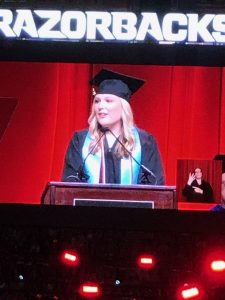15 Ceremonial Speaking: Identification, Magnification, Narration
Lynn Meade

Words have incredible power.
They can make people’s hearts soar,
or they can make people’s hearts sore.
– Dr. Mardy Grothe
psychologist and author
The category of speeches that you are most likely to have to give is ceremonial speeches. Ceremonial speaking, originally called epideictic oratory, includes graduation speeches, wedding speeches, eulogy speeches, after-dinner speeches, award speeches, toast speeches, and tribute speeches. The biggest thing that these have in common is that they have a heavy emphasis on pathos-emotion. When listening to a ceremonial speech, an audience expects to feel something and to feel a part of something. To achieve that, a good ceremonial speech will include identification, narration, and magnification.
In many ways, special occasions are the punctuation marks of life.
They are the rituals that draw us together
in celebration of some person or event
Teri and Michael Gamble
communication scholars
This chapter will look at identification, magnification, and narration and how they function in ceremonial speeches to help you prepare to construct a speech of your own.
Types of Ceremonial Speeches
- Speech of Introduction
- Award Speech
- Acceptance Speech
- Graduation Speech
- Tribute Speech (Can be to a person, occasion, or monument)
- Eulogy Speech
- After Dinner Speech
- Toast Speech
Identification
In all speeches, the audience should feel like you are considering their needs, this is especially true in a ceremonial speech. In a ceremonial speech, your audience in some way becomes part of the speech. To achieve this, you should use a lot of phrases like “we” and “our.” In the graduation speech by Matthew McConaughey, he uses “we,” and “you” words over 400 times–that is a lot of identification!
Matthew McConaughey Graduation Speech
A Lesson in Identification
https://www.youtube.com/watch?v=BmCTQ_mkzHU
Identification
He uses “you” nearly 250 times and “we” 170 times in a 45-minute speech
- You guys and girls, and young men and women are the reason I’m here.
- I’m really looking forward to talking with you all tonight.
- You heard my dad played football here.
- I thought about what you would want, I thought about what you might need.
- I also thought about what I want to say and what I need to say. Hopefully, we’re both going to be happy on both
- It means you got an education. It means you have more knowledge in a specific subject, vocation. It means you may have more expertise in what your degree is in. But what’s it worth in the job market out there today?
- So, while we’re here, and they’re going to run across the jumbotron, let’s make it a place where we break a sweat. Where we believe, where we enjoy the process of succeeding in the places in ways that we are fashioned to.
Fun fact: Matthew McConaughey is a professor of practice at the Moody College of Communication at the University of Texas at Austin. https://moody.utexas.edu/faculty/matthew-mcconaughey
Include Phrases That Provide Identification |
|
|
|
More Examples of Identification
Here are a few ways that my students used identification in their speeches.
The Survivor Tree, an Elm, still stands as a witness of that day as a symbol of our resilience. The same kind of resilience all Americans have when faced with a tough obstacle to overcome. Tribute to OK City Memorial
My grandpa Jack is like the wind. We can’t see him but we can feel him. He is always with us.
Lily, Tribute to Grandpa JackToday, we gather here to honor a famous, and beloved man, Stanley Martin Lieber. We all knew him as Stan Lee
He brought us together
He may be gone but we will not forget what for he did for us.
David Lester, Tribute to Stan Lee

Tip for Identification
When I do one-on-one speech consultations. I pull up two or three empty chairs and then I ask the person who I am coaching to tell me who is sitting in the chair and listening to their speech. I ask them to show me how that person is included in the speech. I read parts of their speech out loud with them thinking about people in those chairs and then we talk about how we can reword some things to make sure those folks feel included.
Magnification
In addition to identification, ceremonial speeches should contain magnification. Magnification is where you take an attribute of a person, and you magnify it and make it seem larger than life. It is where you highlight a positive attribute of a person or group. This works best if you tap into values that the audience share.
These are the most common magnification themes:
- Triumph over obstacles
- Unusual accomplishment
- Superior performance
- Unselfish motive
- Benefit to society
- The greatness of a simple thing
- Celebrate heroic acts and deeds
It is easiest to understand how these work in a speech by way of example. Watch the following speeches to understand how magnification can be achieved.
Oprah Winfrey’s Eulogy to Rosa Parks
A Lesson in Magnification: Triumph Over Obstacle
Magnification is where you make an action larger than life. Notice how Oprah Winfrey elaborates on the action of Rosa Parks and makes it large and heroic.
I grew up in the South, and Rosa Parks was a hero to me long before I recognized and understood the power and impact that her life embodied. I remember my father telling me about this colored woman who had refused to give up her seat. And in my child’s mind, I thought, “She must be really big.” I thought she must be at least a hundred feet tall. I imagined her being stalwart and strong and carrying a shield to hold back the white folks.
…So I thank you again, Sister Rosa, for not only confronting the one white man who[se] seat you took, not only confronting the bus driver, not only for confronting the law, but for confronting history, a history that for 400 years said that you were not even worthy of a glance, certainly no consideration. I thank you for not moving.
And in that moment when you resolved to stay in that seat, you reclaimed your humanity, and you gave us all back a piece of our own.
Bill Clinton’s Eulogy for Muhammad Ali
A Lesson in Magnification: The Greatness of a Simple Thing
Before Mohammad Ali passed, he struggled with tremors. In this eulogy speech, Former President Clinton describes watching him light the Olympic flame. The mere act of walking was a simple thing that was made great by the circumstances.
Finally after all the years that we have been friends, my enduring image of him is like a little reel in three shots: the boxer I thrilled to as a boy, the man I watched take the last steps to light the Olympic Flame when I was president, and I’ll never forget it, I was sitting there in Atlanta, by then we knew each other, by then I felt that I had some sense of what he was living with, and I was still weeping like a baby, seeing his hands shake and his legs shake and knowing by God he was gonna make those last few steps, no matter what it took. The flame would be lit. The fight would be won. The spirit would be affirmed. I knew it would happen.
Rick Rigsby Graduation Speech
Lessons from a third grade drop out
A Lesson in Magnification: Superior Performance
Narration- Tell a Story
In addition to identification and magnification, ceremonial speeches should include stories.

This example is from a University of Arkansas student speech and he is telling the story of picking out his first dog. Notice how the small details help to draw us in and help us to see the event unfold. I left this sample in speech format so you could see how it was written on his manuscript to have a feeling for the rhythm of the speech. (/// slanted lines, signal a pause…the more lines, the longer the pause)
It was a nice day and I can still picture you running towards me
when I really try that is
As we approach the house,///
three little girls
accompanied by their father
open a shed door to the side of the property
I rode my Heelys /// down a small
//concrete sidewalk
Excited to see the little balls of fluff
My parents said to pick a good one
So I picked you /// because you bit my shoe.
Bryan Stevenson Tells a Story in an Award Acceptance Speech
Bryan Stevenson, author of Just Mercy: A Story of Justice and Redemption gave this acceptance speech when winning the Andrew Carnegie Medal for Excellence in Fiction and NonFiction. Notice how his use of narration makes us feel something about his grandmother and then we carry those feelings as he talks about racial justice.
I had a very close relationship with my grandmother. My grandmother was the daughter of people who were enslaved. Her parents were born into slavery in Virginia in the 1840s. She was born in the 1880s, and the only thing that my grandmother insisted that I know about her enslaved father is that he learned to read before emancipation, and that reading is a pathway to survival and success. So I learned to read. I put books and words in my head and in my heart, so that I could get to the places that she needed me to go.
I’m thinking about my grandmother tonight, because she had these qualities about her. She was like lots of African American matriarchs. She was the real force in our family. She was the end of every argument. She was also the beginning of a lot of arguments! She was tough, and she was strong but she was also kind and loving. When I was a little boy, she’d give me these hugs, she’d squeeze me so tightly I could barely breathe. And then she’d see me an hour later and she’d say, “Bryan, do you still feel me hugging you?” And if I said no, she would assault me again!
Did you notice the magnification (the greatness of a simple thing) in learning to read and in hugging?
Did you notice his use of identification by saying, “She was like lots of African American matriarchs?”
Speaking of identification, check out how he uses “we”
We need to change the narrative in this country about race, and poverty. We’re a country that has a difficult time dealing with our shame, our mistakes. We don’t do shame very well in America, and because of that we allow a lot of horrific things to go unaddressed.
Read the whole speech here:
You can use identification, magnification, and narration in all your speeches, but these three elements are especially important in ceremonial type speeches. Maya Angelou said, “People will forget what you said, people will forget what you did, but people will never forget how you made them feel.”
Key Takeaways
Remember This!
- Identification means to relate to your audience.
- Magnification means to find traits about the person you are talking about and magnify them.
- Narration means to tell a story to help your audience feel something.
- Ceremonial speeches should always include identification, magnification, and narration.
Please share your feedback, suggestions, corrections, and ideas.
I want to hear from you.
Do you have an activity to include?
Did you notice a typo that I should correct?
Are you planning to use this as a resource and do you want me to know about it?
Do you want to tell me something that really helped you?
References
Albanese, A. (2015). Is this the greatest book award acceptance speech ever? Publisher’s Weekly. https://www.publishersweekly.com/pw/by-topic/industry-news/awards-and-prizes/article/67546-is-this-the-greatest-book-award-acceptance-speech-ever.html
Clinton, B. ( 2020). Bill Clinton’s eulogy for Muhammad Ali. [Video]. YouTube. https://www.youtube.com/watch?v=feGjy5bKMb0 Standard YouTube License.
Gamble, T. & Gamble, M.W. (1998). Public Speaking in the Age of Diversity. Allyn and Bacon.
Justis, T. (2019). Photo of graduation speaker, Anna Francis Chandler.
Lester, D. Tribute to Stan Lee. University of Arkansas.
McConaughey, M. (2016). Matthew McConaughey University of Houston Speech. https://www.youtube.com/watch?v=BmCTQ_mkzHU
Rigsby, R. (2017). The most inspiring speech: The wisdom of a third-grade dropout will change your life. [Video]. YouTube. https://www.youtube.com/watch?v=Bg_Q7KYWG1g Standard YouTube License.
Samovar, L. A., & McDaniel, E. R. (2007). Public speaking in a multicultural society. Los Angeles, CA: Roxbury.
Saylor Academy (2012). Stand up speak out: The practice and ethics of public speaking. Saylor Academy.
Snippe, E. (2016). 101 quotes to inspire speakers. Angelou, M. Quote. https://speakerhub.com/blog/101-quotes
Thibodeau, P.H and Boroditsky, L. (2011). Metaphors we think with: The role of metaphor in reasoning. Stanford University.
Winfrey, O. (2010). Oprah eulogy [Video]. YouTube. https://www.youtube.com/watch?v=5cfhtfNfIPE&t=1s Standard YouTube License.
Media Attributions
- Anna-Frances at University of Arkansas Graduation © Tuesdae Justis is licensed under a CC BY (Attribution) license
- kelly-miller-BL6XQLZeXpg-unsplash © Kelly Miller is licensed under a CC BY (Attribution) license
- mia-anderson-xzE4-0gSYuo-unsplash © Mia Anderson is licensed under a CC BY (Attribution) license

